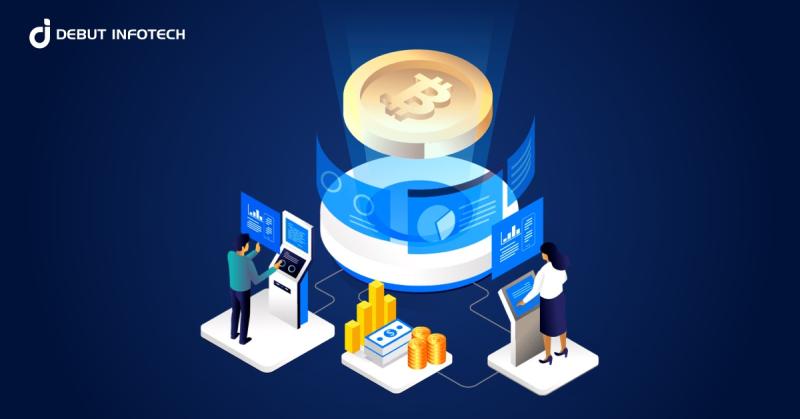Hyperledger Development Services: Building the Next-Gen Blockchain Solutions
Hyperledger, an open-source collaborative project hosted by the Linux Foundation, is designed to advance cross-industry blockchain technologies. It provides a suite of tools, frameworks, and libraries tailored for building secure, scalable, and flexible blockchain solutions.
This article explores the core aspects of Hyperledger development services, including their benefits, a comprehensive development guide, criteria for choosing the right development partner, and the challenges associated with Hyperledger development.
What are Hyperledger Development Services?
Hyperledger development services refer to the suite of tools, frameworks, and libraries provided by the Hyperledger project to facilitate the creation of blockchain applications. Hyperledger, an open-source collaborative effort hosted by the Linux Foundation, is designed to advance cross-industry blockchain technologies. It includes a range of modular projects like Hyperledger Fabric, Sawtooth, Indy, Burrow, and others, each tailored for specific use cases and needs. These development services enable businesses to build a reliable business model, private, permissioned blockchain networks with enhanced security, scalability, and performance compared to public blockchains.
Benefits of Hyperledger Development Services
1. Enhanced Security
Hyperledger provides robust security features essential for enterprise-grade applications. Its permissioned network model ensures that only authorized participants can access and validate transactions, reducing the risk of unauthorized access and fraud.
2. Scalability
Hyperledger frameworks are designed to handle a large volume of transactions efficiently. They support high throughput and can be scaled horizontally to meet the growing demands of enterprise applications.
3. Modularity
Hyperledger's modular architecture allows developers to customize the blockchain network according to specific business requirements. This flexibility ensures that only the necessary components are used, optimizing performance and resource utilization.
4. Interoperability
Hyperledger development services promote interoperability between different blockchain networks. Projects like Hyperledger Quilt enable seamless integration with existing systems and other blockchain platforms, facilitating data exchange and collaboration.
5. Governance and Transparency
Hyperledger provides robust governance structures that ensure transparent and democratic decision-making processes. This fosters trust among participants and encourages wider adoption of the blockchain network.
6. Cost Efficiency
By leveraging open source blockchain technologies and reducing reliance on intermediaries, Hyperledger blockchain development services can significantly lower operational costs. The transparency and immutability of blockchain also reduce the need for extensive audits and reconciliations.
Step-by-Step Guide on Hyperledger Development
1. Define the Use Case
Identify the specific business problem that can be solved using blockchain technology. Ensure that blockchain is the right solution for the problem and outline the key objectives and requirements of the project.
2. Select the Appropriate Hyperledger Framework
Choose the most suitable Hyperledger framework based on the use case. For instance, Hyperledger Fabric is ideal for supply chain management and financial services, while Hyperledger Sawtooth is suitable for digital asset creation and management.
3. Set Up the Development Environment
Install the necessary tools and dependencies required for Hyperledger development. This includes Docker, Go, Node.js, and the Hyperledger framework's specific components.
4. Design the Network Architecture
Define the network topology, including the number of nodes, peers, and orderers. Determine the consensus mechanism to be used and configure the network accordingly.
5. Develop Smart Contracts (Chaincode)
Write the business logic that will be executed on the blockchain network. In Hyperledger Fabric, this is done using Chaincode, typically written in Go, JavaScript, or Java.
6. Deploy the Network
Set up and configure the blockchain network on a local or cloud-based infrastructure. Launch the network and deploy the smart contracts to the appropriate channels.
7. Integrate with Existing Systems
Develop APIs and interfaces to connect the blockchain network with existing enterprise systems and applications. This ensures seamless data flow and enhances the overall functionality of the blockchain solution.
8. Test the Network
Conduct comprehensive testing to ensure the network operates as expected. Perform unit tests, integration tests, and performance tests to identify and resolve any issues.
9. Monitor and Maintain
Implement monitoring tools to track the performance and health of the blockchain network. Regularly update the network components and smart contracts to incorporate new features and address any vulnerabilities.
10. Scale and Optimize
As the network grows, continuously optimize the infrastructure for better performance and scalability. Implement load balancing, sharding, and other techniques to handle increased transaction volumes.
By following these steps, businesses can effectively develop and deploy blockchain solutions using Hyperledger, unlocking the full potential of this powerful technology.
Factors to Consider When Selecting the Right Hyperledger Development Company
The right Hyperledger development company can significantly impact the success of your blockchain project. Choosing a partner with the appropriate expertise, experience, and approach is critical for achieving your objectives efficiently and effectively. Here are key factors to consider when selecting a Hyperledger development company:
1. Technical Expertise and Experience
a) Proven Track Record: Assess the company’s portfolio to ensure they have successfully delivered Hyperledger projects. Case studies and client testimonials provide insights into their capabilities and reliability.
b) Certified Professionals: Look for a team with certified Hyperledger developers. Certifications indicate a solid understanding of Hyperledger frameworks and best practices.
c) Depth of Knowledge: Evaluate the company’s expertise in various Hyperledger frameworks (e.g., Fabric, Sawtooth, Indy). Their ability to recommend the right framework for your use case is crucial.
2. Comprehensive Service Offerings
a) End-to-End Solutions: The company should offer a full range of services, from initial consulting and requirement analysis to development, deployment, and maintenance.
b) Custom Development: Ensure they can provide customized solutions tailored to your specific business models rather than one-size-fits-all approaches.
c) Integration Capabilities: The ability to integrate the blockchain solution with your existing systems and applications is essential for seamless operations.
3. Security and Compliance
a) Robust Security Measures: Verify that the company prioritizes security in their development processes. This includes data encryption, access control, and regular security audits.
b) Compliance Expertise: The company should be knowledgeable about relevant regulations and standards in your industry, ensuring that the blockchain solution complies with all legal and regulatory requirements.
4. Innovation and Use of Latest Technologies
a) Adoption of Cutting-Edge Tools: A forward-thinking company will leverage the latest tools and technologies in blockchain development to deliver innovative solutions.
b) Active Participation in the Hyperledger Community: Companies that contribute to the Hyperledger community are often more knowledgeable and stay updated with the latest advancements.
5. Communication and Collaboration
a) Transparent Communication: Effective and transparent communication is vital for project success. The company should provide regular updates and be open to feedback throughout the project lifecycle.
b) Collaborative Approach: Look for a company that values collaboration and works closely with your team to understand your vision and goals.
6. Scalability and Flexibility
a) Scalable Solutions: The company should have the capability to develop solutions that can scale with your business needs. This includes handling increased transaction volumes and adding new features as required.
b) Flexible Engagement Models: Choose a company that offers flexible engagement models, such as fixed-price, time and material, or dedicated team models, to suit your project requirements and budget.
7. Support and Maintenance
a) Ongoing Support: Post-deployment support is critical for the smooth functioning of your blockchain solution. Ensure the company offers comprehensive maintenance and support services.
b) Proactive Issue Resolution: The company should have a proactive approach to identifying and resolving issues promptly to minimize downtime and ensure continuous operation.
8. Cost and Value
a) Cost Transparency: The company should provide a clear and transparent pricing model with no hidden charges. Compare their pricing with the value and quality of services offered.
b) Return on Investment (ROI): Evaluate the potential ROI of their services. A higher upfront cost may be justified if the company can deliver a superior solution that drives long-term benefits.
9. Reputation and Reviews
a) Industry Reputation: Research the company’s reputation within the industry. Positive reviews and recognition from reputable sources can indicate their reliability and expertise.
b) Client Testimonials: Client feedback and testimonials provide insights into the company’s strengths and areas for improvement. Reach out to their past clients if possible for firsthand accounts of their experience.
10. Geographic Location
a) Proximity: Depending on your preferences, the geographic location of the company might be a factor. Local companies can offer the advantage of face-to-face meetings and better understanding of regional regulations and market dynamics.
b) Global Reach: Conversely, a company with a global presence can bring diverse perspectives and experiences, potentially offering more innovative solutions.
Challenges of Hyperledger Development Solutions
While Hyperledger offers a robust platform for developing blockchain solutions, it is not without its challenges. Understanding these challenges is crucial for businesses and developers to effectively navigate the complexities of Hyperledger development. Here are the key challenges associated with Hyperledger development solutions and insights on how to address them:
1. Complexity of Setup and Configuration
Setting up and configuring a Hyperledger network platform can be complex and time-consuming. The modular architecture, while flexible, requires a thorough understanding of various components and their interactions.
Solution: Comprehensive documentation and community resources are available to assist in the setup process. Engaging with experienced Hyperledger developers or consulting services can also expedite the configuration and ensure best practices are followed.
2. Steep Learning Curve
As a blockchain based technology, Hyperledger development has a steep learning curve, especially for developers new to blockchain technology. The need to understand different frameworks, consensus mechanisms, and smart contract development adds to the complexity.
Solution: Investing in training and certification programs for developers can significantly reduce the learning curve. Hyperledger offers extensive tutorials, workshops, and certification courses to equip developers with the necessary skills.
3. Scalability Concerns
Although Hyperledger is designed to be scalable, managing scalability in practice can be challenging. As the network grows, ensuring consistent performance and managing increased transaction volumes require careful planning and execution.
Solution: Implementing horizontal scaling, load balancing, and optimizing consensus algorithms can help manage scalability. Regular performance testing and monitoring are essential to identify and address potential bottlenecks.
4. Security Risks
Ensuring the security of a Hyperledger network is paramount. Despite its robust security features, vulnerabilities can arise from improper implementation, inadequate access controls, and flaws in smart contracts.
Solution: Adopting a security-first approach in development is crucial. Regular security audits, penetration testing, and adhering to best practices in smart contract development can mitigate security risks. Utilizing Hyperledger’s built-in security features, such as data encryption and identity management, is also essential.
5. Integration with Existing Systems
Integrating Hyperledger solutions with existing enterprise systems can be complex and challenging. Ensuring seamless data flow and compatibility between different systems requires thorough planning and execution.
Solution: Developing APIs and middleware to facilitate integration can address compatibility issues. Engaging with integration experts and utilizing Hyperledger tools designed for interoperability, such as Hyperledger Quilt, can streamline the integration process.
6. Maintenance and Upgrades
Maintaining and upgrading a Hyperledger network requires continuous effort and expertise. Ensuring network stability while implementing updates and new features can be challenging.
Solution: Establishing a robust maintenance strategy, including regular updates, monitoring, and proactive issue resolution, is essential. Engaging with the Hyperledger community and staying informed about the latest developments can help in managing upgrades effectively.
7. Governance and Consensus
Establishing effective governance and consensus mechanisms in a Hyperledger network can be complex. Different participants may have varying interests and requirements, making it challenging to reach consensus.
Solution: Implementing clear governance structures and transparent decision-making processes is crucial. Utilizing Hyperledger’s modular consensus mechanisms allows for flexibility in choosing the most suitable method for the network. Regular communication and collaboration among participants also foster effective governance.
8. Resource Intensive
Hyperledger development can be resource-intensive in terms of both time and cost. The need for skilled developers, infrastructure setup, and ongoing maintenance can strain resources.
Solution: Planning and budgeting carefully for Hyperledger projects is essential. Leveraging open-source resources, engaging with experienced development partners, and adopting efficient development practices can optimize resource utilization.
9. Legal and Regulatory Compliance
Ensuring legal and regulatory compliance is a significant challenge in Hyperledger development. Different jurisdictions have varying regulations that impact the implementation and operation of blockchain networks.
Solution: Engaging legal experts with experience in distributed ledger like blockchain and staying informed about relevant regulations are crucial steps. Implementing compliance measures from the outset and conducting regular audits can ensure adherence to legal requirements.
10. User Adoption and Training
Encouraging user adoption and ensuring adequate training for end-users can be challenging. Users may be resistant to change or unfamiliar with blockchain technology.
Solution: Providing comprehensive training programs and user-friendly documentation can facilitate user adoption. Demonstrating the benefits of the Hyperledger solution and offering continuous support can also encourage users to embrace the new technology.
Conclusion
Hyperledger development services represent a transformative approach to building blockchain solutions, offering a host of benefits such as enhanced security, scalability, modularity, and cost efficiency.
A well-chosen development partner will not only deliver a robust and secure blockchain solution but also provide the support and flexibility needed to adapt and thrive in a rapidly evolving technological landscape.
Debut Infotech stands out as the ideal partner for Hyperledger development, combining deep technical expertise with a commitment to innovation.










Comments